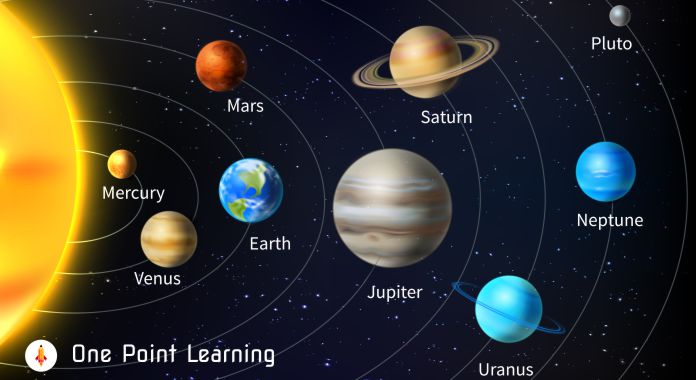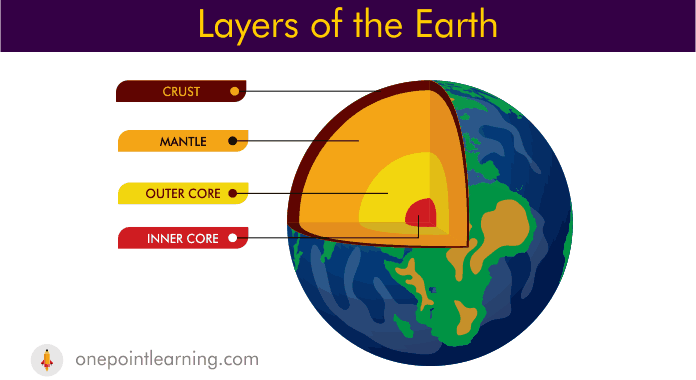Our solar system is like a big family of objects that orbit around the sun in a fixed path.
It consists of the sun, eight planets, their moons, and other celestial bodies such as asteroids, comets, and dust.
The solar system is located in the Milky Way galaxy and is about 25,000 light-years from the centre of the galaxy.

Click on each link to download our specially designed solar system worksheet for class 4 students.
We are now on WhatsApp – Click to Join Us
Read Also:
Free Science worksheets for Class 4
NCERT Hindi Worksheets for Class 4
The Sun
The Sun is a crucial part of our solar system, providing us with the energy and warmth necessary for life on Earth.
- It is a giant ball of hot, glowing gas that gives us light and heat
- without Sun there will be no life on Earth
- Light takes about 8 minutes and 20 seconds to reach Earth
- The Sun is about 4.6 billion years old
- All planets and other object revolve around the Sun

Planets in the solar system
The solar system consists of eight planets, four inner planets and four outer planets, each with its own unique characteristics and properties.
The eight planets in the solar system are: Mercury, Venus, Earth, Mars, Jupiter, Saturn, Uranus, and Neptune.
The four inner planets, Mercury, Venus, Earth, and Mars, are called the terrestrial planets because they are mostly made of rock and metal.
The four outer planets, Jupiter, Saturn, Uranus, and Neptune, are called the gas giants because they are mostly made of gas.
The Earth
Earth is a wonderful and most beautiful place in the universe. It is the only planet supporting life.
- It’s the only planet to have life on it
- Also called the “Blue Planet” because of 71% water on its surface
- Has an atmosphere that contains oxygen for us to breathe
- Different forms of life coexist on the earth
- The rotation of Earth gives us day and night
- The revolution of Earth causes different seasons
- Earth has one moon, which is its natural satellite

Layers of the Earth
The layers of the Earth affects everything from the gravitational force to the magnetic field of our planet. The Earth is made up of three layers, core, mantle and crust.
Crust: The crust is like the Earth’s outer skin. It is the coolest and thinnest layer. It’s the layer we live on, where the land and oceans are formed. Furthermore, it is made of rocks such as granite and basalt.
Mantle: Beneath the crust is the mantle. The mantle is a lot hotter than the crust. It is the thickest layer made of rocks rich in minerals. The movement of the mantle creates the Earth’s tectonic plates, which can cause earthquakes and volcanic eruptions.
Core: The innermost layer below the mantle is called core. It is divided into two parts, outer and inner core.
Outer Core: The outer core is very, very hot, and it’s made of melted metals, mostly iron and nickel. This hot, molten metal is what creates the Earth’s magnetic field.
Inner Core: At the very centre of the Earth is the inner core. It’s super hot and made of solid iron and nickel. It has a temperature of about 4000 degree Celsius.
Movements of the Earth
The Earth has several two important movements, rotation and revolution.
Rotation:
- Earth rotates, or spins, on its axis. The axis is an imaginary line that runs from the North Pole to the South Pole.
- Earth’s axis is tilted at an angle of 23.5 degree.
- It takes approximately 24 hours for Earth to complete one full rotation.
- The rotation causes day and night on the earth.
- The equator is an imaginary line running through the centre of the Earth at an angle of 90 degree to the axis.
Revolution:
- Earth also moves in its orbit around the Sun. This movement is called revolution.
- It takes about 365.25 days for Earth to complete one full orbit around the Sun.
- The one revolution is called a solar year.
- The revolution of Earth causes change of seasons.
- The tilt of Earth’s axis plays a significant role in creating the changing seasons.
- Different parts of the Earth receive varying amounts of sunlight throughout the year, and thus causes seasons.
- Noon is the hottest part of the day, as the sun is directly overhead.
What is Revolution and Rotation in planets?
The sun is at the centre of the solar system, and it is a star. It is the source of light and heat for the solar system.
The planets orbit the sun in elliptical paths, and they rotate on their axis.
The time it takes for a planet to orbit the sun is called its year, and the time it takes for a planet to rotate on its axis is called its day.



Excellent worksheets, it helps in clearing the concepts.
As a parent, it helped me to check the depth of my kid.